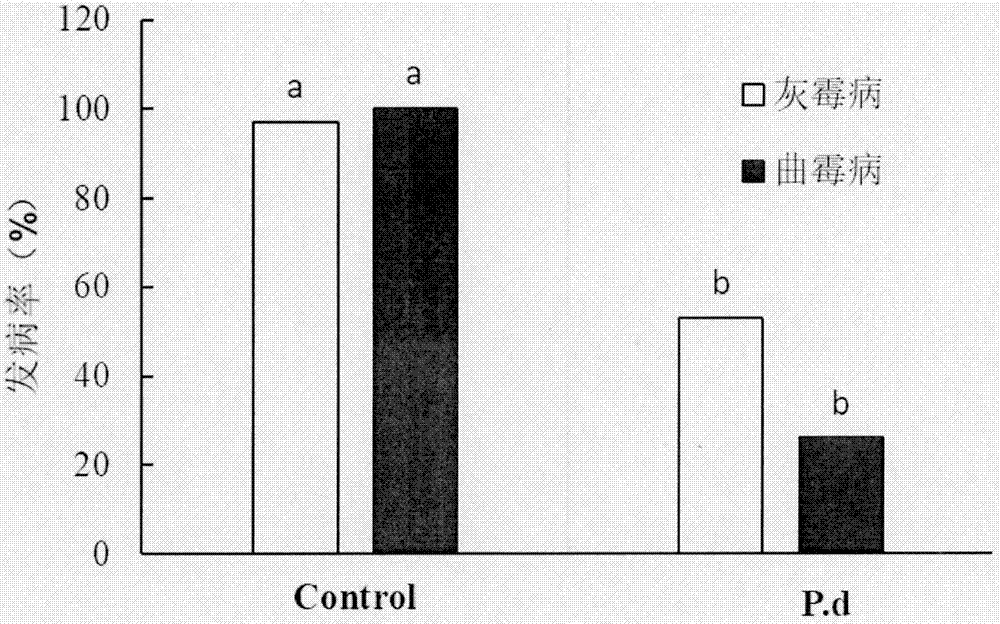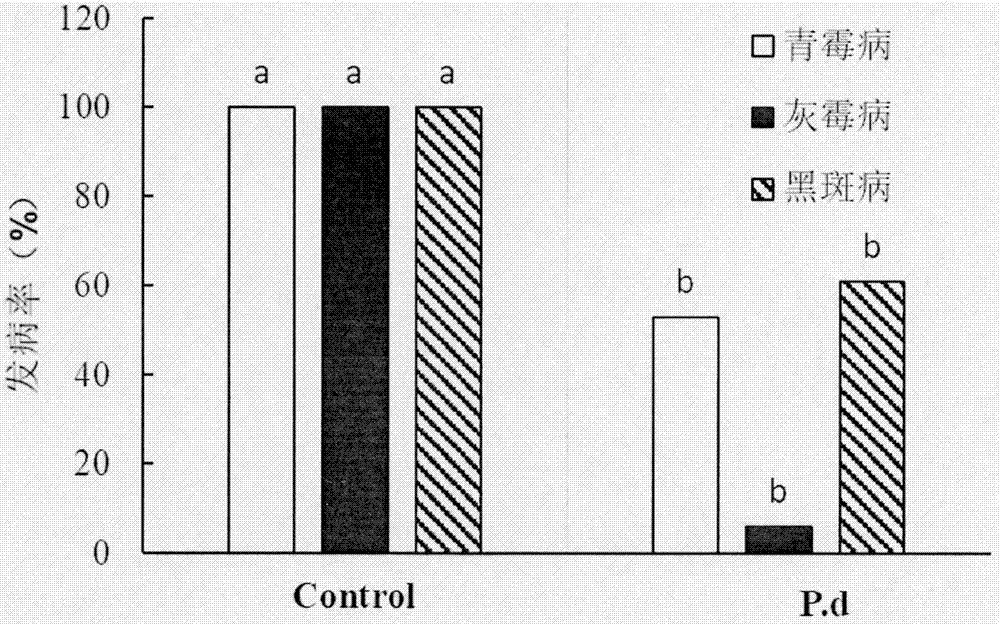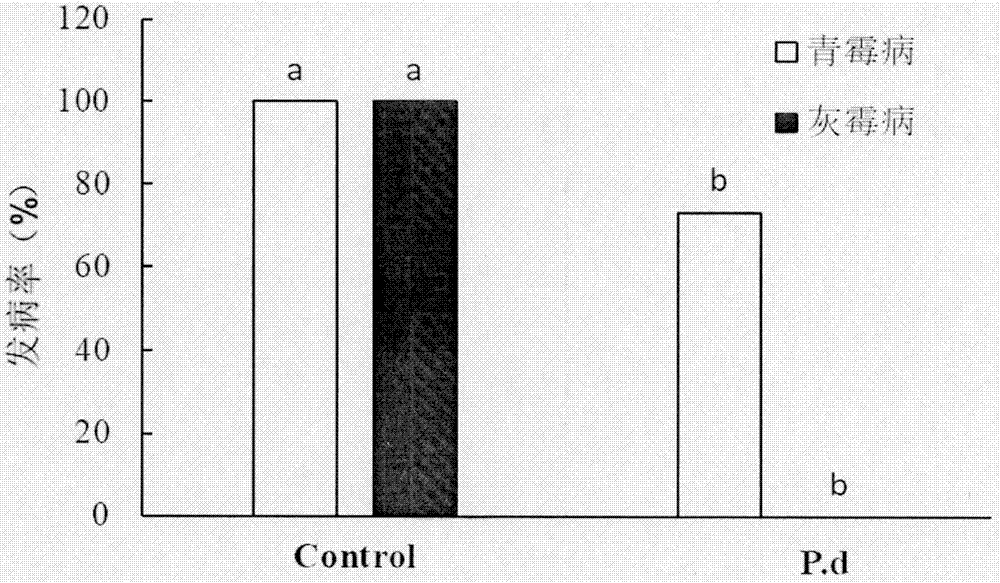Antagonistic yeast Pichia deserticola and preparation and use method thereof
A Pichia pastoris and strain technology, applied in the field of Pichia pastoris, can solve the problems of lack of bacteriostatic spectrum strains, biocontrol effects are only verified on a few fruits, etc., achieving significant social and ecological benefits, low cost of use, good quality The effect of the application foreground
- Summary
- Abstract
- Description
- Claims
- Application Information
AI Technical Summary
Problems solved by technology
Method used
Image
Examples
Embodiment 1
[0017] Example 1: Biological properties of Pichia deserticola strain BY25
[0018] 1. Morphological features
[0019] (1) YPDA medium (1% yeast extract powder, 2% peptone, 2% glucose, 1.8% agar, sterilized at 121°C for 20 minutes) was cultured at 26°C for 48h, and the colonies were round and white with smooth and round edges. The cell shape is ellipsoidal.
[0020] (2) After culturing in YPDA liquid medium for 24 hours, no mold was formed, the bacterial solution was turbid, and there was precipitation. Microscopically, the yeast cells were oval and budded.
[0021] 2. Molecular biological identification
[0022] Use the universal forward primer NL-1 (5'-GCATATCAATAAGCGGAGGAAAAG-3') and the reverse primer NL-4 (5'-GGTCCGTGTTTCAAGACGG-3') to PCR amplify the yeast 26S rDNA D1 / D2 region nucleic acid sequence, and PCR The sequencing results of the product were entered into the website www.NCBI.nlm.nih.gov for BLAST, the homologous sequences were downloaded from the GenBank datab...
Embodiment 2
[0024] The inhibitory effect of implementation example 2 Pichia BY25 to apple blue mold, botrytis cinerea and black spot
[0025] 1. Experimental protocol
[0026] Pichia BY25 was taken out from the -80°C refrigerator, activated with YPDA medium (10g of yeast extract powder, 20g of peptone, 20g of glucose, 18g of agar, 1000ml of deionized water, natural pH, sterilized at 121°C for 30min), and picked a single Colony into YPD liquid medium, culture at 26°C and 200r / min for 24h, centrifuge at 4000rpm for 5min, discard the supernatant, wash the collected bacteria repeatedly with sterile water for 3 times, count on a hemocytometer to prepare the concentration 1×10 8 cells / mL of Pichia BY25 suspension.
[0027] Activate Penicillium expansum, Botrytis cinerea or Alternaria tenuissima on PDA medium plate, culture at 26°C for 7-14 days, scrape appropriate amount of spores, wash with sterile water Prepared to a concentration of 5 x 10 4 cells / mL of Penicillium, Botrytis, or Alternar...
Embodiment 3
[0037] The inhibitory effect of implementation example 3 Pichia BY25 on pear fruit blue mold and black spot
[0038] 1. Experimental protocol
[0039] Pichia BY25 was taken out from the -80°C refrigerator, activated with YPDA medium (10g of yeast extract powder, 20g of peptone, 20g of glucose, 18g of agar, 1000ml of deionized water, natural pH, sterilized at 121°C for 30min), and picked a single Colony into YPD liquid medium, culture at 26°C and 200r / min for 24h, centrifuge at 4000rpm for 5min, discard the supernatant, wash the collected bacteria repeatedly with sterile water for 3 times, count on a hemocytometer to prepare the concentration 1×10 8 cells / mL of Pichia BY25 suspension.
[0040] Activate Penicillium expansum or Botrytis cinerea on a PDA medium plate, culture at 26°C for 7-14 days, scrape appropriate amount of spores, and prepare a concentration of 5×10 with sterile water. 4 cells / mL of Penicillium or Botrytis cinerea spore suspension. Healthy and undamaged pe...
PUM
 Login to View More
Login to View More Abstract
Description
Claims
Application Information
 Login to View More
Login to View More - R&D
- Intellectual Property
- Life Sciences
- Materials
- Tech Scout
- Unparalleled Data Quality
- Higher Quality Content
- 60% Fewer Hallucinations
Browse by: Latest US Patents, China's latest patents, Technical Efficacy Thesaurus, Application Domain, Technology Topic, Popular Technical Reports.
© 2025 PatSnap. All rights reserved.Legal|Privacy policy|Modern Slavery Act Transparency Statement|Sitemap|About US| Contact US: help@patsnap.com



